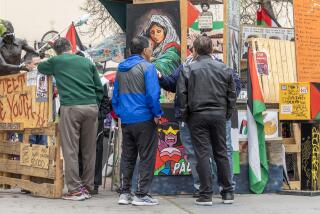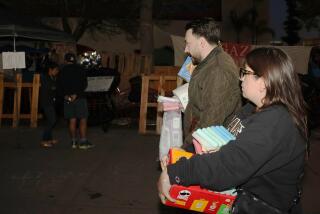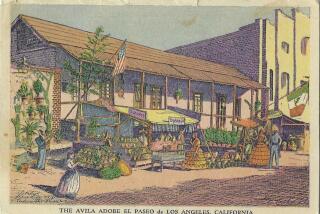To change the church 50 years ago, first they had to break in

- Share via
A crowd of Mexican American protesters pounded on the locked doors of St. Basil’s, an opulent new Catholic church on Wilshire Boulevard.
To them, the multimillion-dollar house of worship was a symbol of extravagance by the Archdiocese of Los Angeles leaders — and a sharp contrast to the poverty too many Catholics endured in East L.A.
“Let the poor people in!” they shouted, as midnight Mass began inside on a Christmas Eve half a century ago.
When they finally got into the lobby, off-duty sheriff’s deputies moonlighting as ushers were waiting. Fist-swinging, pushing, screaming and kicking broke out. A couple of demonstrators were injured; more than 20 would be arrested.
Inside, members of the city’s Catholic elite sang “O Come, All Ye Faithful” to drown out the noise.
As the service ended, Cardinal James Francis McIntyre likened the young Latinos to storied men on the wrong side of history, such as those who stood at the foot of the cross shouting “Crucify him!”
“Forgive them,” McIntyre told the parishioners, “they know not what they do.”
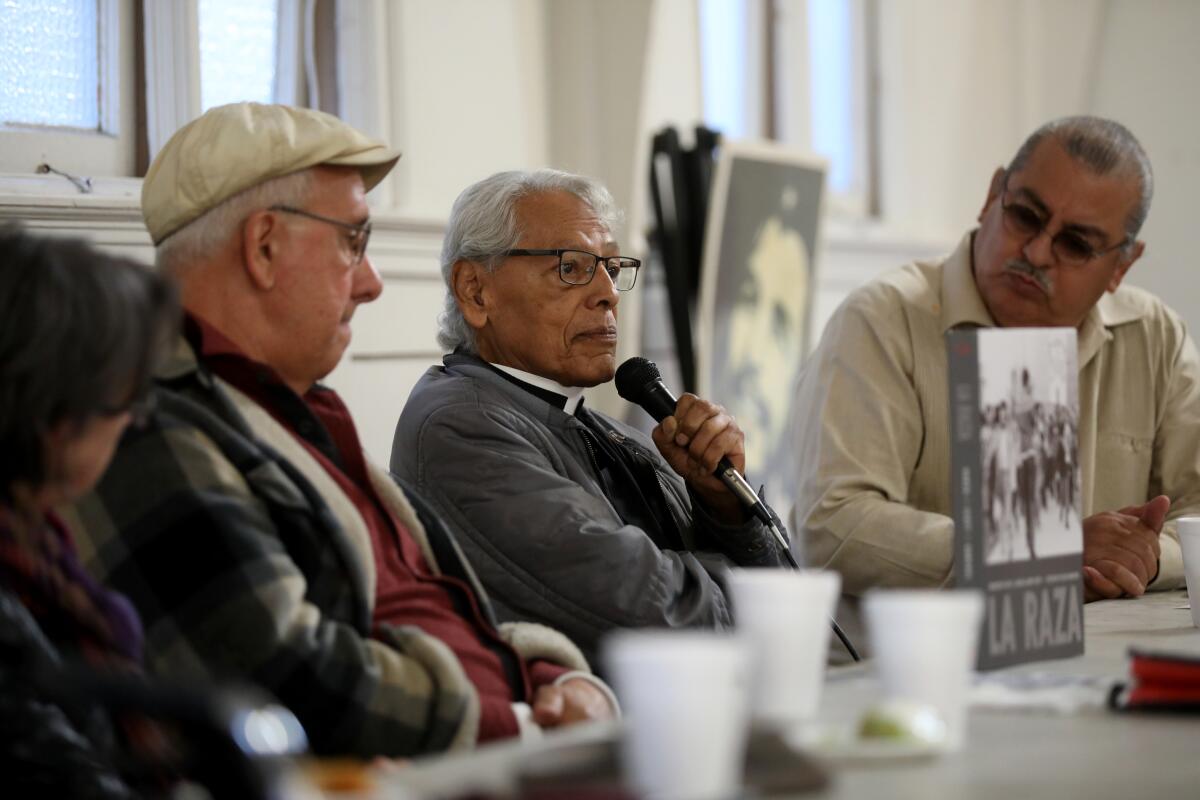
Fifty years later, members of Católicos por La Raza (Catholics for the People) — the group that had so angered McIntyre — gathered in a different church. They are in their 70s. They get around on walkers. Their hair has thinned and shines white.
This time, they were not there to protest but to celebrate the events of December 1969 and all that followed. In January 1970, Cardinal McIntyre retired. His successor, Archbishop Timothy Manning, said he would listen to militants seeking social change.
Members of Católicos por La Raza say their actions helped pave the way for the subsequent change in the relationship between the Catholic Church in the United States and Latino congregants. Before the St. Basil’s affair, bishops and cardinals treated them largely as peons, they said, downplaying their patron saints or any hint of social justice in favor of a conservative theology with European Catholicism in the forefront.
But in the decades since, Latinos and their causes moved to the forefront of American Catholicism, driven largely by the faithful in L.A.
Church leaders supported Cesar Chavez’s United Farm Workers union, and embraced Central American refugees during the 1980s; today, the United States Conference of Catholic Bishops is consistently pro-immigrant and led by Los Angeles Archbishop José Gomez. His archdiocese is the nation’s largest, with Latinos comprising more than 70% of L.A.’s 5 million Catholic parishioners.
The incident at St. Basil’s, though, is rarely taught. It was overshadowed by other milestones in Chicano history. Nevertheless, the people behind it were pivotal actors for Chicano activism in Southern California.
“Católicos was a who’s who of L.A. activists,” said Felipe Hinojosa, an associate professor of history at Texas A&M University who has interviewed the group’s members for a book on Latino radical politics and religious institutions.
“They were willing to just be as brash and as bold as they were with L.A. school districts, with the walkouts, with every other major institution. They were not going to be reverent.”
On Jan. 11, about two dozen people filled a room in the Episcopal Church of the Epiphany. Decades ago, farm labor leader Chavez gave talks in the Lincoln Heights church. La Raza, an underground pro-Chicano newspaper, was printed in the basement.
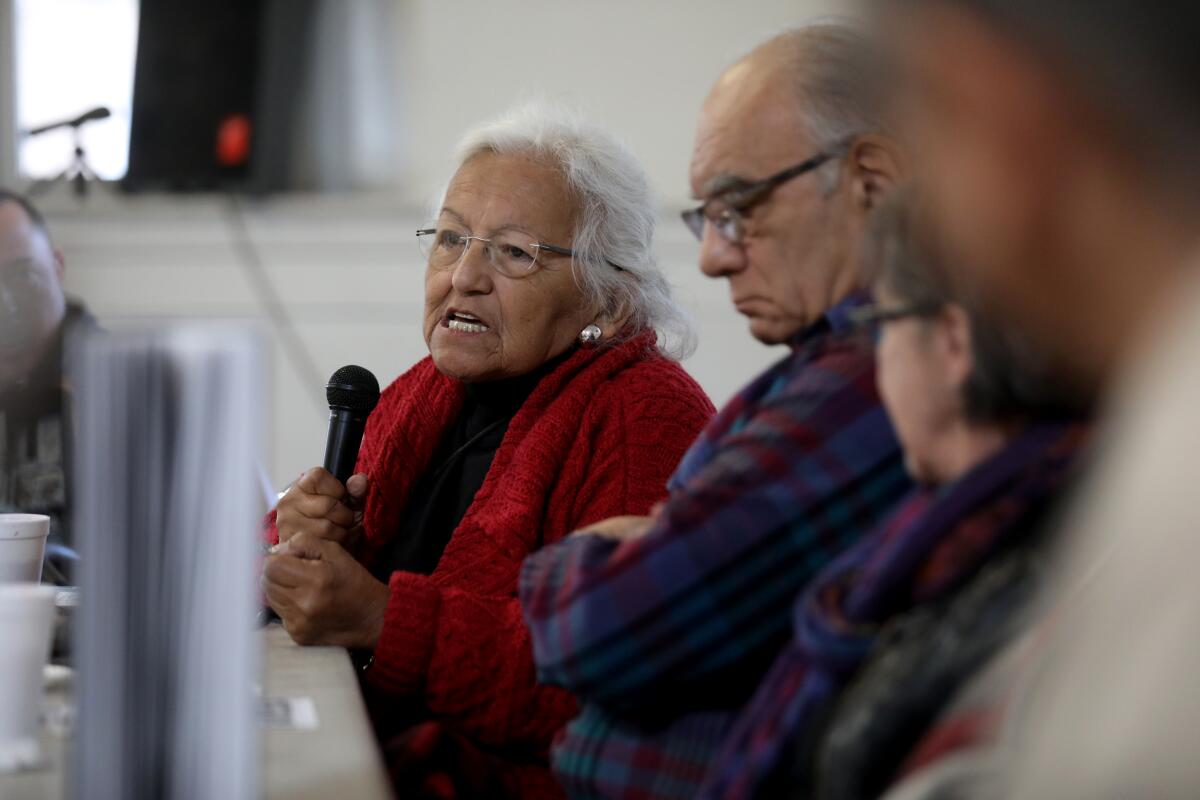
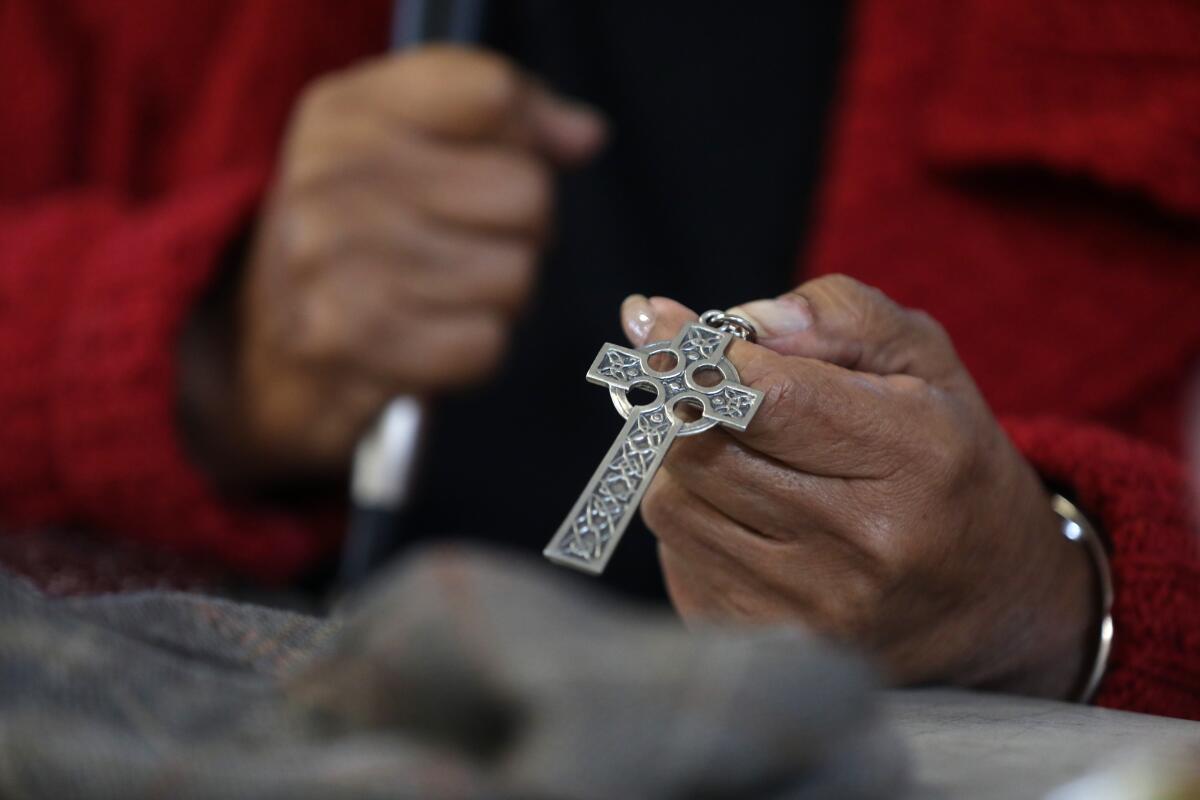
“Welcome home,” said Father Tom Carey, the church’s vicar. “We would not have a resistance — what is happening today — if it were not for you.”
“¡Viva la raza!,” he said.
“¡Que viva!” they shouted.
The event centered on some of those arrested decades ago for protesting the Catholic Church and what could be done to deal with challenges in 2020. They greeted one another with tight embraces; the men used “carnal,” brother. The room, cold enough to keep on jackets and sweaters, was warmed by the reunions.
Attendees snacked on flautas and drank agua de jamaica as they waited for everything to start. The event began an hour late because, as an organizer joked, people were on “Chicano time.”
On each table were program handouts featuring photos of 20 men and women. Underneath each name was either “guilty” or “not guilty” to signal their conviction.
Lydia Lopez, who had “not guilty” below her photo, directed her fellow activists to a table at the front of the room.
“Oh, we’re doing a lineup,” Luis Garza said with a smile.
“Yeah, we’re going to have another lineup,” Lopez joked.
Lopez was 28 when her ex-husband, a member of Católicos, told her on Christmas Eve that they were going to church. She recalled in vivid detail the hot pink dress she wore and the black patent heels.
These days, the heels are gone. The 77-year-old used a red walker to navigate the reunion. At times, she cupped a hand around her ear, prompting people to speak up.
Lopez had been self-conscious during her participation in the protest, she admitted, because she was Episcopalian — not Catholic. She just wanted to stand up “for the justice of this issue.”
Lopez was pregnant with her son at the time of her arrest. He would later joke that he and his mother went to jail to make things better.
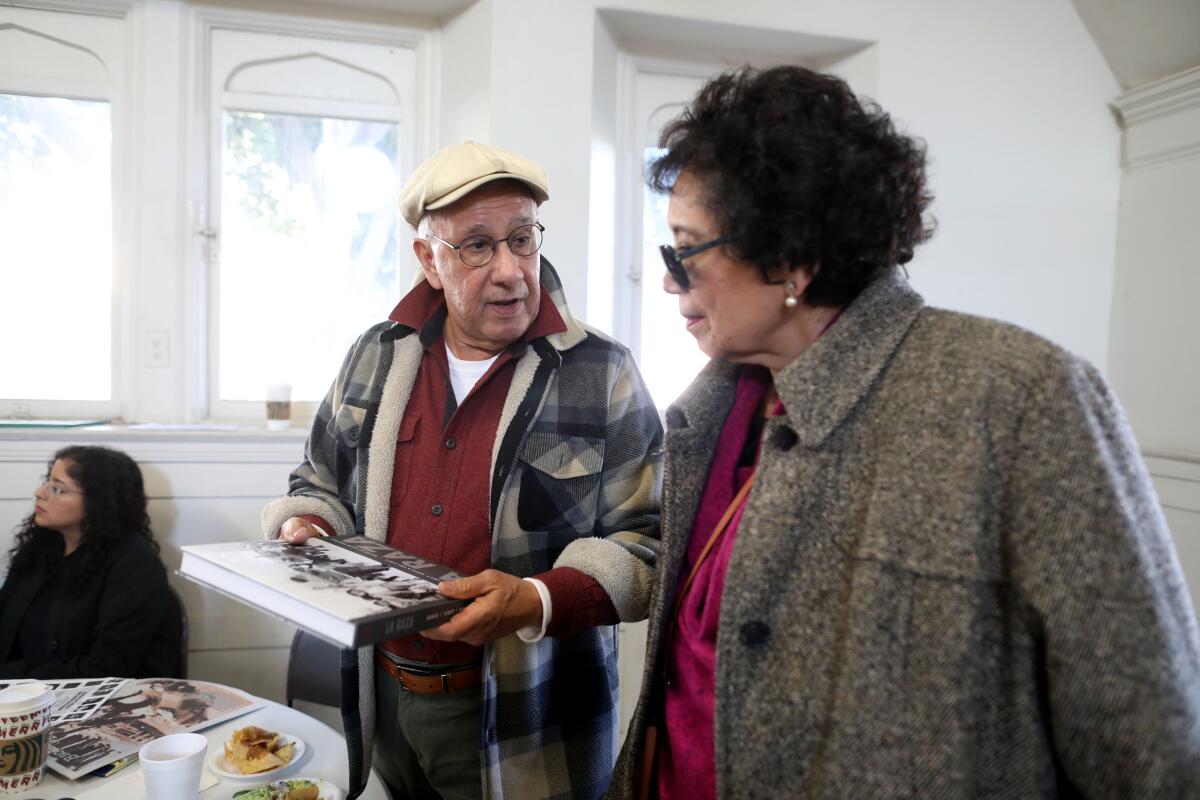
One of Lopez’s lawyers was Oscar “Zeta” Acosta, an activist lawyer used as the inspiration for Dr. Gonzo in Hunter S. Thompson’s “Fear and Loathing in Las Vegas.” He helped prove that she had been across the street during the St. Basil’s melee.
Lopez was found not guilty and became active in the Episcopal Church. She worked in the communications and public affairs office in the Episcopal Diocese of L.A. until her retirement 10 years ago.
She and Armando Vazquez-Ramos, the youngest of those prosecuted, helped organize the anniversary reunion. A few of their fellow activists were dead; others they were unable to track down. As they read the names of the departed, everyone called out, “presente.”
Vazquez-Ramos, who was born in Mexico City, was a 20-year-old student at Cal State Long Beach when he “turned on to this Chicano movement spirit.” He almost dropped out of school the first semester because he became a “24/7 activist.”
That night at St. Basil’s, he and a few others went into the church through the basement and opened the doors. Vazquez-Ramos later pleaded guilty to disturbing the peace so that prosecutors would drop charges against two other defendants. He was sentenced to a year of supervised probation and fined $50.
“Like is the case with any generation, we all grew up,” said Vazquez-Ramos, whose hint of a mustache eventually grew in and turned gray. “We all graduated, we became parents and we became employed — which was the nemesis of all us activists.”
Vazquez-Ramos, who co-founded the Chicano and Latino Studies department at Cal State Long Beach, taught at the university for more than 30 years. He began a program five years ago to teach ethnic studies in high schools.
“I’m very much proud of that generation and what we accomplished and how we’ve been able to grow in 50 years,” Vazquez-Ramos said.
Behind the table where the speakers sat was a framed poster for the National Chicano Moratorium, a massive anti-Vietnam War protest on Aug. 29, 1970.
Attendees, most of them longtime activists, flipped through a photo book that Garza helped curate titled “La Raza,” which included pictures of antiwar rallies. Latinos linked arms and held signs that read “Fuera de Vietnam” and “Bring Our Carnales Home Now.”
Garza began his career as a photojournalist at La Raza magazine. He became “the premier photographer of the Chicano movement,” a friend said. He was arrested after the St. Basil’s incident but found not guilty.
In one photo by La Raza staff, Richard Cruz, a leader of Católicos, stood on the steps of St. Basil’s in September 1970. He and others burned their baptismal certificates.
Cruz, then a Loyola Law School student, received the stiffest sentence after the St. Basil’s incident, according to a 1970 Times article. About a month before that protest, Cruz tried to meet with Cardinal McIntyre, a towering figure in the history of California Catholicism.
McIntyre was widely credited for overseeing the rapid growth of the archdiocese. But he clashed with civil rights organizations and was accused of racism.
After being told to wait, the group’s members burst into the cardinal’s private office. They watched as his face turned beet red.
“I thought the Holy Ghost was going to come down,” Rosa Martinez recounted.
The group’s members demanded that the church pay attention to the needs of Latinos and give them a voice in church affairs. If McIntyre had listened, they said, the St. Basil’s melee might never have happened.
Now in their 70s, Católicos members know that their efforts have largely been forgotten — eclipsed by Chavez, the East L.A. walkouts and the Chicano Moratorium. It’s what some of those in attendance called a “historical amnesia.”
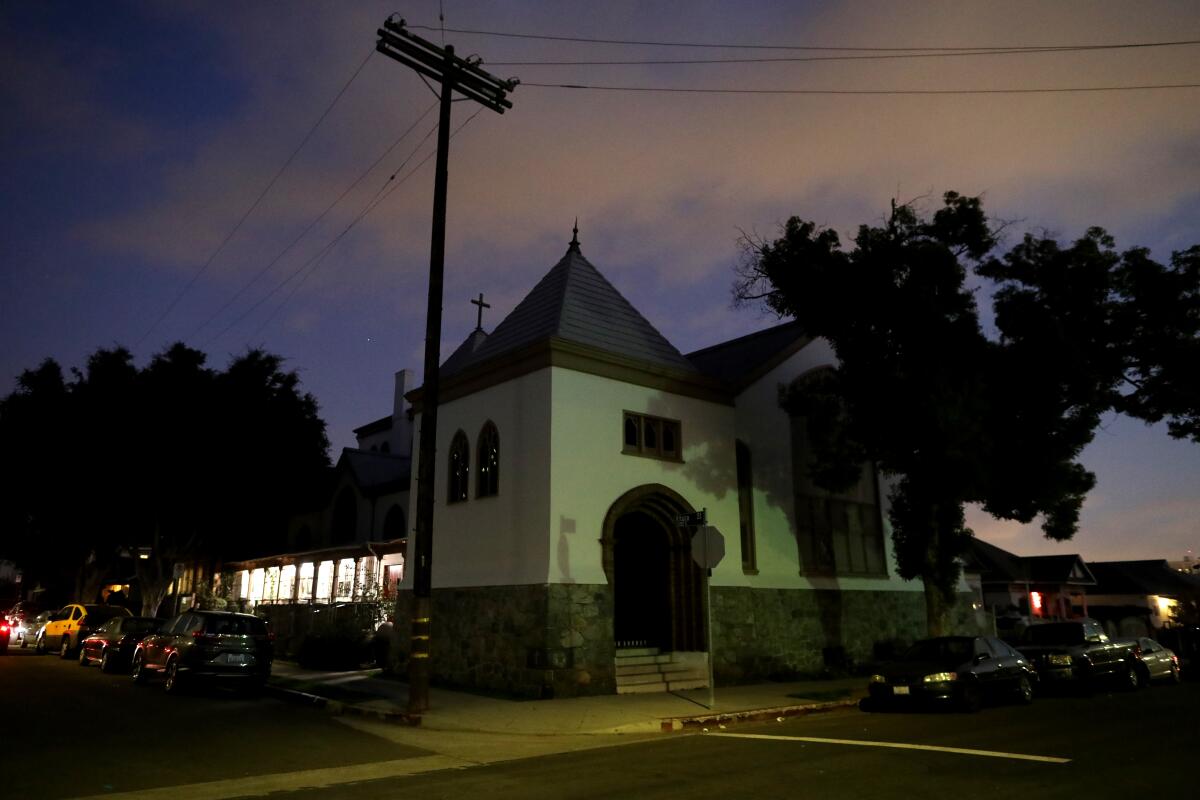
“The Católicos por la Raza issue is so buried in history, even in Chicano studies we don’t teach about it,” Vazquez-Ramos said. Even the L.A. Archdiocese struggled to find someone familiar with the events of 1969.
Those young activists became lawyers and professors. Cruz died in 1993, but his son, Camilo, and ex-wife, Rosa Martinez, attended the event.
Camilo Cruz runs the Community Justice Initiative for the L.A. city attorney’s office, with the intent of diverting people out of the criminal justice system.
“Without you I wouldn’t have had any opportunities the way we have them now,” Cruz said to those seated at the table. “You guys opened the doors.”
Talk turned to the current political climate and the fact that the movement no longer seemed to be moving. Attendees worried about President Trump and asked what could be done in the next 50 years. One man wore a blue button that read “Impeach & Remove.”
The issues of decades ago felt “earthshaking,” said Richard Martínez, who was among those arrested back then. But “probably not as earthshaking as the issues we face today.”
“I would hope that the energy and dynamism that the Chicano movement had could be reflected in the generations that are taking on issues of today,” Martínez said. “We need another Chicano movement.”
More to Read
Sign up for Essential California
The most important California stories and recommendations in your inbox every morning.
You may occasionally receive promotional content from the Los Angeles Times.

